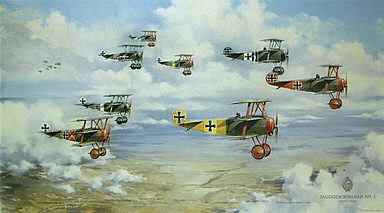Richthofens Flying Circus, March 1918
This aviation art print by Claus Friedl Wuelfing depicts Rittmeister von Richthofens 'Flying Circus'. The Jagdgeschwader (Fighter Wing) No. 1 was created from the Jagdstaffen, also called Jasta (Fighter Squadrons) 4, 6 10 and 11 by order of the Chief of Staff of the Army 1c No. 5834-lop dated June 23, 1917. On June 24, 1917, the commanding General of the Luftstreitkraefte (Air Force) announced that the Fighter Wing was to be a self contained unit dedicated to achieving and maintaining aerial supremacy over decisive combat sectors. There was only one logical choice for the leader of this unique formation. The next day, Rittmeister Manfred von Richthofen, formerly in command of Jasta 11, was appointed commanding officer of the first Jagdgeschwader in German military history. The art prints shows eight Fokker DR 1 triplane fighters from Jasta 6 and 11 over northern France in March 1918. In the background to the left we see a group of Albatros D.V and Pfalz D.III assigned to Jasta 4 and 10.
At this point in time, no less than three different types of fighter plane in various versions were serving in the unit. English pilots referred to the Jagdgeschwader as the 'Flying Circus'. Historians are unsure about the origins of this unusual name. Maybe it was due to the colourful decoration of the aircraft, or possibly the extreme mobility of the Jagdstaffeln, which could be deployed at any crucial sector along the front at very short notice, in the manner of a travelling circus.
After the Jagdgeschwader had been formed, each Jasta retained its own original colour markings. For example, the triplanes in Jasta 6 had a black cowling and broad black and white stripes on both horizontal stabilizers, whereas the aircraft in Jasta 11 had their cowlings, struts and fabric wheel covers painted in red. To ensure that they could be identified more easily by their own comrades, many aircraft were also decorated with personal emblems together with the Jasta markings. These varied from coloured fuselage bands and symbols right through to a nearly complete repainting of the aircraft, quite often in the colours of the former regiment in which they had served. A good example is the aircraft flown by Lothar von Richthofen, Manfred's younger brother. In addition to the red markings of Jasta 11, he had parts of his triplane painted yellow as a reference to his old regiment, the 1. Schlesische Dragonerregiment No. 4.
In this art print the name of the pilot of each of the aircraft is imprinted in the bottom image area. Only the version signed by the artist in pencil is still available.
Open Edition
- unsigned (sold out)
- signed by the Artist (very low stock)





